Fat bikes are known for their ability to handle any surface thrown their way. Sand is something that can be pretty tricky to handle, depending on several factors. For starters, loose sand can make riding just as slippery as riding in fresh snow. Sand also is easy to get muddy, which further complicates how to ride.
Any fat bike is capable of handling a little bit of sand along the way, but for those people who are always riding on this type of surface, it might be better to invest in something built specifically for it. This will make each ride a little more efficient, and the tires will last a long time as well.
The tires in this article all handle sand very well. What many people will find out is that tires that handle sand well, also handle many other surfaces. These are all great overall tires to consider, but those who do a lot of riding on the beach or sand should pay particularly close attention.
1. Schwalbe Jumbo Jim
The first thing that people notice when shopping around for fat bike tires made for the sand is that none of these tires have a lot of knobs on them. These more knobbly type of tires don’t help much in the sand, as it gets in the way of rolling efficiently.
The key to a fat bike tire made for the sand is finding one that has a lot of width, and low rolling resistance. That is why the Schwalbe Jumbo Jim comes in a 4.0” and 4.8” option, with a relatively smooth surface.
The tire spreads the weight across the entire surface area very well, allowing riders to float on the sand instead of digging in. There are still knobs on the tire but spread out to provide less resistance. This helps with anything from sand to trail riding, and even on pavement.
It is worth noting that riding on sand is a challenge, so the better the tires are built to handle everything, the sweeter the experience will be.
Click here for the current price for the Schwalbe Jumbo Jim.
2. Kenda Juggernaut Pro
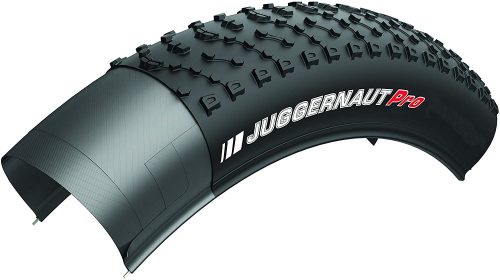
A lot of people look at these tires as great options on dirt. The only difference is that with dirt, people tend to go with a slightly skinnier tire for a bit more speed and precision. If the sand is a bit wet, or a person like a skinnier tire anyway, the Kenda Juggernaut Pro is a good option to consider.
This bike can tear up dirt thanks in large part to its fast-rolling setup. Instead of worrying about how the tire will roll in the sand, riders pretty much understand that it will glide across pretty well.
It is also built for speed because it has the ability to stay strong at a light weight. It is one of the lightest fat bike tires out there right now, which equates to a very smooth ride even in the finest sand that seems impossible to navigate through.
Fewer dismounts on sand equal a better ride overall, and that is something most fat bike riders can get behind.
Click here for the current price on the Kenda Juggernaut Pro.
3. Panaracer Fat B Nimble
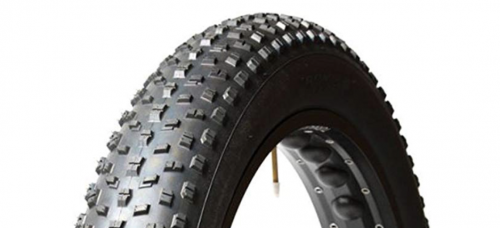
This lightweight fat bike tire has a tread pattern made for any season and any terrain, including sand. The Fat B Nimble from Panaracer gets a lot of things right, except for the fact that it is not available as a tubeless option.
People who have made the change likely do not want to go back, so that limits the number of people who will be interested in this tire.
Since the tire is lightweight and does not have any huge knobs, riding at a very low psi is going to provide a comfortable experience on the sand. It is easy to knife through even the heavy, loose sand that so many people hate having to deal with.
It is not the most talked-about tire out there, but at a price point that is pretty affordable for a well-known brand, maybe it should start getting more notoriety.
The tire looks pretty simple, but people heading to the beach should consider a tire that has a similar look. Tires with opportunities for sand and debris to build up on them usually just end up being a hassle more than anything.
Click here for the current price for the Panaracer Fat B Nimble.
4. Vee Tire Bulldozer
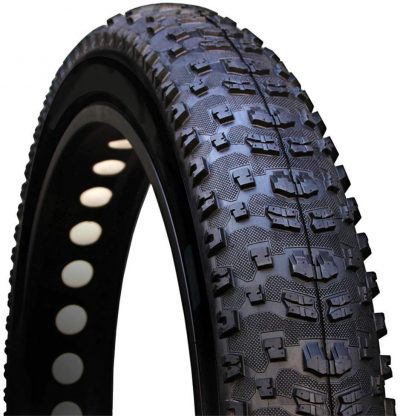
If flotation is the main goal with a brand new tire, the Vee Tire Bulldozer is an excellent option to consider. This is where a person can get some superb traction in those loose snow and sand conditions.
The tread is very low for a fat bike tire, which is good news for people who want very little rolling resistance. It has a pretty aggressive center for people to count on if they want to, and the knobs on the side of the tire help with stability and keeping things moving in a straight line.
When battling the sand, this tire has a lot that people really enjoy using. The only downfall is that it is probably a little heavier than some people would like, but it is not too much that it hinders performance.
Don’t be afraid to use this as a typical trail riding fat bike tire as well. So many people have benefited from this in the past as a standard trail tire. Only recently have people noticed that it does an outstanding job on the sand, and therefore should be a solid choice to have for those beach visits.
Click here for the current price for the Vee Tire Bulldozer.
5. Vittoria Bomboloni

Vittoria makes this type of tire for both mountain bikes and fat bikes. It has a lot of the same qualities as some of the other fat bike tires out there, but with better rolling ability than ones with heavier and longer knobs. This is why so many people have started using it on the sand, and it has benefited them greatly.
A simple tread pattern is usually going to work best with the sand. As soon as the tire starts to sink into the sand, it becomes that much more difficult to navigate around.
People are continually looking for packed sand that is hard enough for better navigation. When it is extremely loose, a tire with a pattern like this is about the only way to survive.
The Italian company is known for producing tires that last for a very long time. So many people have started using them consistently for not only specific fat bike needs but for basically any type of tires for a fat bike.
Click here for the current price for the Vittoria Bomboloni.
Questions Regarding Fat Bikes in the Sand
Riding in the sand can be a very challenging experience for any fat bike rider. That is why it is important to have the right set up before going all in.
While just about any fat bike will do a better job than a typical beach cruiser, it is still essential to know some of the tricks of the trade, as well as other tips before heading out.
Why are specific fat bike tires so expensive?
When shopping for new fat bike tires, one frustrating part that many come to realize is that it’s pretty expensive. The tires last a very long time, but it is disappointing to see just how much money needs spent upfront to upgrade.
Fat bike tires are expensive for a few reasons. For starters, a lot of time and effort goes into designing a particular type of tire. It is not a mass-produced option that so many people are used to finding at the local store.
Everything on this tire is crafted for the individual so that they can handle tougher trains.
The material is also something that just costs a little bit more to put everything together and ensure that high quality. Tires must consist of material that will not puncture when out on a trail.
There can be so many different things that challenge a fatbike tire and put a lot of pressure on it. By using quality material that holds up, people don’t have to worry about possibly putting themselves in danger.
Maintaining bikes in sand
Fat bikes are very durable and can handle so much, but it is still important to properly take care of the bike after use. Otherwise, some permanent damage is possible, resulting in failed components and even faster bike replacements in the end.
Sand not only scratches off the paint on a bike, but it can really do damage in the chain area. Not only does it make noise when there’s too much sand in there, But it can hurt performance one sand gets stuck in the chain and ring area.
The best way to treat a chain after riding is to use a spray bottle with some degreaser in it to spray and wipe the chain. This will get some of the junk off of the chain, and make it look as good as new.
If it really gets bad, take the chain off completely, or have a local bike shop tech do it. Cleaning or even replacing the chain might be the only way to go once it has a ton of build-up.
Get in the habit of cleaning off the bike a good amount before putting it away each time. Once sand starts to build up, it becomes tougher to remove completely. Stay on top of everything, and the daily maintenance is not that bad.
Are fat bikes allowed on most beaches?
Fat bikes are no different than any other bike a person takes onto the sand at a local beach. As long as they allow beach cruisers, they allow fat bikes.
Buying a fat bike with tires that built specifically to handle sand makes riding so much easier than a beach cruiser, and it leaves less of a trail as well.
People will also use their fat bike to ride off-trail near a beach. It is a great way to navigate all the different surfaces that might pop up in an area like that. On any given trip, a person could spend time on cement, grass, sand, dirt, and more.
Is it better to ride near the ocean on the beach, or far away?
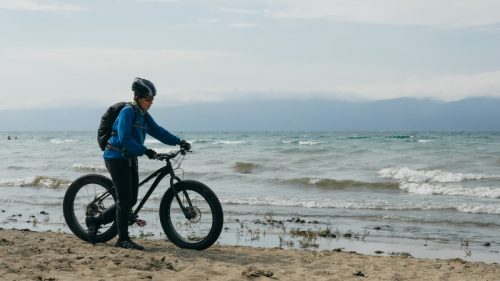
Many people notice when at the beach notice that bike riders will try to get pretty close to the ocean. Riding up and down the shore, they get as close as possible without actually going in. This is not just for a great view, but also because of the surface.
Sand packed in and solid near the ocean, so fat bike riders should try to do the same thing if they want a consistent ride. It might resemble that of a soft track to ride on instead of anything too challenging, but the ride is still fun for fat bikers.
It is worth noting that people should avoid getting the bike too wet. It will inevitably get wet from time to time, but saltwater on the fat bike and components can wear things down much faster than usual.
You should wash or at least rinse your bike if you do get saltwater all over the frame and the components.
Why investing in fat bike tires for the sand matters
People who go to the beach a lot, or want to start making it a habit, should definitely look into buying fat bike tires specifically for the sand.
Having that little bit of an edge with a proper tire when riding around can make life a lot easier. Not only will people have the ability to ride faster, but safer as well. There is no reason to ride a fat bike around without considering safety at all times.
Remember that sand is very tough to navigate through if a person doesn’t have the right set up. There are beach cruisers out there that have been around for years, but they do not do nearly as much as a fat bike would when trying to ride on this type of terrain.
So many people try to go through thick sand, only to fail. Instead of trying with an inferior bike, invest in a fat bike ready to take on the beach.

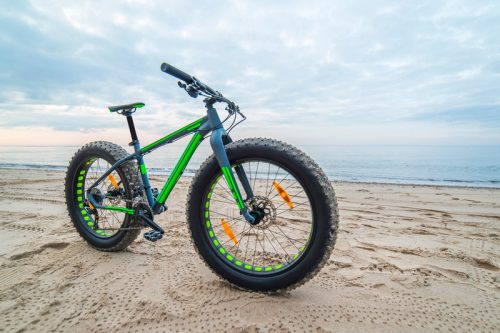

2 thoughts on “5 Best Fat Bike Tires For Sand Riding – 2021”